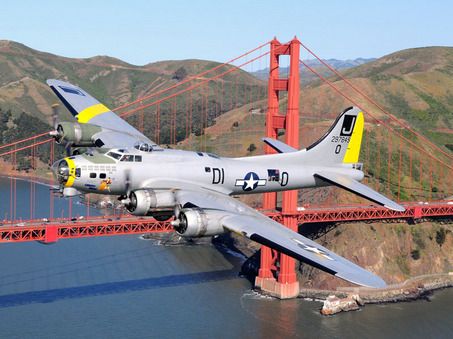Page 1 sur 1
triste nouvelle. Un 17 en moins.
Publié : lun. juin 13, 2011 8:35 pm
par Merlin (FZG_Immel)
" a écrit :Aircraft History
The B-17G (SN 44-85734) did not see combat in World War II, and was originally sold on June 25, 1947 as scrap to Esperado Mining Co. of Altus, OK, it sold again later that year to Pratt & Whitney for $2,700. Pratt & Whitney operated the B-17 from November 19, 1947 to 1967 as a heavily modified test bed for their P&W T34 turboprop engine under the registration N-5111N. Similar to registration numbers 44-85747 and 44-85813, it became a “5-engine aircraft”, having the powerful prototype engine mounted on the nose. The aircraft was flown “single-engine,” with all four radial engines feathered during test flights. Following the test flights, it was donated to the Connecticut Aeronautical Historic Association, where a tornado on October 3, 1979 blew another aircraft onto the B-17’s mid-section, breaking the fuselage.

B-17 44-85734 was eventually purchased by aviation enthusiast Don Brooks, who formed the Liberty Foundation to exhibit the plane as the "Liberty Belle." Restoration began in 1992 with parts from another damaged B-17 (44-85813). Restoration by Tom Reilly and company/Flying Tigers Warbird Restoration Museum (aka "Bombertown USA") located at that time at Kissimmee Gateway field Kissimmee, Florida. Evidence of the rebuild may be seen in very professional stringer splices aft of the waist gun positions. She returned to the air December 8, 2004, and has been touring the air show circuit since then. The Liberty Foundation also planned a historic overseas tour in July 2008 along the northern ferry route to England.


Aircraft Loss
On June 13, 2011, the Liberty Belle crashed in Oswego, Illinois after taking off from Aurora Municipal Airport in Sugar Grove, Illinois. Early reports indicate that shortly after takeoff, the pilot reported an engine fire, and attempted to return to the airfield. He was unable to do so, however, and chose instead to put the aircraft down in a nearby cornfield with 7 people on board, all of whom are reported to be safe.







CD
Publié : lun. juin 13, 2011 8:43 pm
par JulietBravo
Sale temps pour les
warbirds multimoteurs...
Dommage !

Publié : lun. juin 13, 2011 8:59 pm
par fabien321
belle bête...domage
Publié : lun. juin 13, 2011 9:02 pm
par Rodolphe
...
Suivant les images du lien ci-dessous,on ne peut pas vraiment parler d'un crash.
L'équipage a effectué un "Emergency Landing" en campagne suite à une alarme feu au moteur #2.
L'incendie s'est ensuite propagé rapidement, détruisant complètement l'appareil.
http://www.dailyherald.com/article/2011 ... 15/photos/
Après les "commercials"
http://www.cbsnews.com/stories/2011/06/ ... 0852.shtml
http://www.wlwt.com/r/28219940/detail.html
...
Publié : lun. juin 13, 2011 9:50 pm
par JulietBravo
Bel atterrissage "aux vaches", en effet.
Au final, ça a sauvé l'équipage, mais pas l'appareil.
Feu moteur, comme le B-25 "français"...
Publié : lun. juin 13, 2011 10:56 pm
par Rodolphe
...
Pour la petite histoire de la panne moteur au décollage sur B-25 :
1. le Technical order NO.01-60GB-1, Pilot's Handbook of Flight Operating Instructctions for Modeds B-25C and B-25D préconise :
Section II
Pilot's Operating Instrutions
9.
Engine Failure During Take-Off.
a. Move mixture control to "IDLE CUT-OFF" and cut the ignition of dead engine.
b. ...
c. Put nose of airplane down and make belly landing.

Donc il semble qu'il n'existe pas d'équivalent aux "First & Second segments" sur ce type de B-25.
Sur B-25J, Le pilote doit immédiatement décider si il peut mettre en drapeau l'hélice du moteur en panne et continuer le vol ou
couper le bon moteur et attérrir droit devant lui . La décision doit être basée sur les facteurs de vitesse, de configuration et de poids. voir ci-dessous.


Remarquez la différence de "Single Engine Control Speed" en fonction du moteur.
...
Publié : lun. juin 13, 2011 11:13 pm
par 0rion
Dommage pour le zinc, mais content que l'équipage soit sauf!
Publié : mar. juin 14, 2011 9:39 am
par Corktip 14
Chapeau bas à l'équipage qui l'a ammené au sol en tout cas, grâce à lui tout le monde est sain et sauf.
Triste fin pour ce beau bestiau.
Edit: petite rectification pour faire plaisir à Frank

Publié : mar. juin 14, 2011 5:51 pm
par Franck66
Chapeau bas au pilote
pour avoir volé avec le Pink Lady je peux t'affirmer que faire voler cet avion est un vrai travail d’équipe qui se fait à 3 et pas seulement à un pilote
Publié : jeu. juin 16, 2011 9:45 am
par Flyingtom
Rodolphe a écrit :...
Pour la petite histoire de la panne moteur au décollage sur B-25 :
1. le Technical order NO.01-60GB-1, Pilot's Handbook of Flight Operating Instructctions for Modeds B-25C and B-25D préconise :
Section II
Pilot's Operating Instrutions
9.
Engine Failure During Take-Off.
a. Move mixture control to "IDLE CUT-OFF" and cut the ignition of dead engine.
b. ...
c. Put nose of airplane down and make belly landing.

Donc il semble qu'il n'existe pas d'équivalent aux "First & Second segments" sur ce type de B-25.
Sur B-25J, Le pilote doit immédiatement décider si il peut mettre en drapeau l'hélice du moteur en panne et continuer le vol ou
couper le bon moteur et attérrir droit devant lui . La décision doit être basée sur les facteurs de vitesse, de configuration et de poids. voir ci-dessous.


Remarquez la différence de "Single Engine Control Speed" en fonction du moteur.
...
Merci Rodolphe pour les infos... je me posais la question justement sur la gestion N-1 du B25 ...
Publié : jeu. juin 16, 2011 11:17 am
par ceramix
là c'était feu important a bord, si pas éteint, au bout de 2 minutes on commence à perdre des morceaux d'avion.
il ont du mouiller la chemise.












